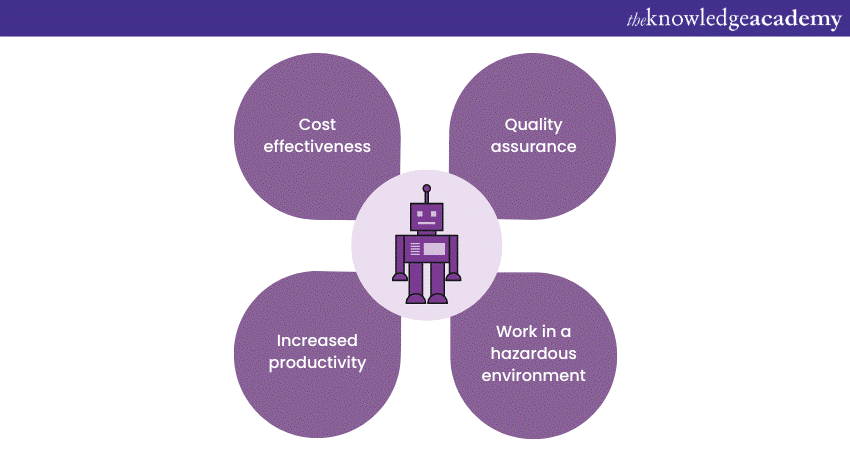We may not have the course you’re looking for. If you enquire or give us a call on 01344203999 and speak to our training experts, we may still be able to help with your training requirements.
Training Outcomes Within Your Budget!
We ensure quality, budget-alignment, and timely delivery by our expert instructors.

Robotics is taking the world by storm spanning across multiple industries. Over the next years, Robotic Automation is expected to continue to gaining popularity as companies seek to benefit from the multitude of benefits, it offers. Undoubtedly it has posed a threat owing to its hazardous potential.
According to Statista, the Robotics market generated over 25 billion GBP in revenue worldwide. Like any technology, Robotics presents both benefits and drawbacks to various domains.
Table of Contents
1) What is Robotics?
2) Advantages of Robotics
3) Disadvantage of Robotics
4) Conclusion
What is Robotics?
Robotics is the interdisciplinary branch of engineering and science that includes mechanical engineering, electrical engineering, computer science, and others. Robotics deals with the design, construction, operation, and use of robots, as well as computer systems for their control, sensory feedback, and information processing.
In this digital age, Robotics represents a transformative shift. As you are all aware, Robotics is utilised extensively in the manufacturing, research laboratories, traffic management, search initiatives, and defense activities. These have streamlined human employees' tasks which was previously performed by humans.
The field of Robotics is estimated to be tremendously booming posing a threat to the job landscape.
Explore comprehensive Robotic Process Automation Training to ensure you are equipped with the knowledge of automating business processes.
Advantages of Robotics
There are various advantages of Robotics, and some of them include:
1) Cost-effectiveness: There will be no time set aside for Robotic Automation during lunch breaks, holidays, sick days, or shifts. It can be designed to operate in a repeated cycle, and if it is maintained properly, it will do so until told differently. This eliminates the possibility of developing Repetitive Strain Injury (RSI).
For every manufacturer, the increase in production at a cheaper cost results in clear advantages. The investment's initial cost can be recouped quite quickly, and the gains after that are, to put it mildly, exponential.
2) Quality assurance: Few workers enjoy performing monotonous activities, and concentration levels will inevitably wane over time. This momentary loss of focus is referred to as vigilance reduction, and it frequently results in costly mistakes for the company as well as occasionally serious employee injuries.
Robotic Automation ensures that products consistently meet the set standards by regularly producing and confirming their quality, thereby eliminating potential risks. The increased production of higher-quality products results in numerous business opportunities.
3) Increased productivity: It makes perfect sense to automate monotonous chores with Robotics. Robots are made to do repetitive tasks. Adding automation to your manufacturing process has a variety of positive effects on productivity, some of which are, optimal machine efficacy, fewer manual delays, and increased manufacturing of goods.
Giving employees the chance to broaden their horizons and operate in different capacities will improve the workplace, which will be advantageous to the company. The output will only get better with more energy and concentration poured into it, which will also result in incredibly happy customers.
4) Work in a hazardous environment: Staff workers in certain industries may be required to work in hazardous or unstable settings in addition to potential occupational injuries. Robotic Automation, for instance, provides the best option in situations where there are a lot of dangers present because it will continue to operate safely.
Due to the nature of the work, production facilities that demand extremely high or low temperatures frequently have a significant risk. Robotic Automation can eliminate the need for people to take excessive risks in such a working environment.

Learn Robotic Process Automation Using UiPath to learn different techniques of automation and to avoid human errors at work
Disadvantages of Robotics
The following are the disadvantages of Robotics:
1) Job losses: The effect on jobs for employees is one of the main concerns surrounding the advent of Robotic Automation. The worry is that if a robot can work faster and more consistently, people might not even be required. These concerns are reasonable, yet they are not entirely true.
2) Initial investment costs: This is one of the main barriers that determine whether a corporation invests in Robotic Automation at present or not. A thorough business case must be developed to evaluate the opportunities and potential shortcomings of such hefty investment.
However, the rewards can be significant in a short period of time. While it's not worth jeopardising the business's stability for minimal returns, maintaining a steady cash flow in the meantime is essential. Generally, a structured repayment plan will be in place, making it easier to handle and manage finances.
3) Emotionless: Robots can never interact as humans do. Robots lack empathy, and this is one of the disadvantages of employing robots to work. Certain tasks require personalised human touch, such as artwork, animations, video making, and other creative domains.
There are also economic disadvantages that the world will face. This can arise due to the breakdown of robotic machines employed at work. The need for large investments added with the maintenance of machines will lower the return on capital. Additionally, electronic waste generation can be a future concern. While on a societal level, there are chances for conflicts to erupt between people who debate their views on robots versus people.

Conclusion
The field of Robotics offers fair share of its advantages and difficulties. On one side, the advantages, such as increased productivity, precision, and efficiency across various sectors like manufacturing and healthcare, are clear. Robotic Automation can minimise mistakes made by humans, bolster safety in high-risk environments, and further our ventures into space and the ocean's depths.
However, serious thought must be given to ethical issues, including the potential loss of human contact in management and decision-making.
Unlock the Future of Innovation by diving into the Scope and Techniques of Robotic Automation Training! Sign up today!
Frequently Asked Questions
Upcoming Advanced Technology Resources Batches & Dates
Date
 Robotic Process Automation using UiPath
Robotic Process Automation using UiPath
Thu 27th Jun 2024
Thu 18th Jul 2024
Thu 12th Sep 2024
Thu 7th Nov 2024
Thu 12th Dec 2024







 Top Rated Course
Top Rated Course


 If you wish to make any changes to your course, please
If you wish to make any changes to your course, please


